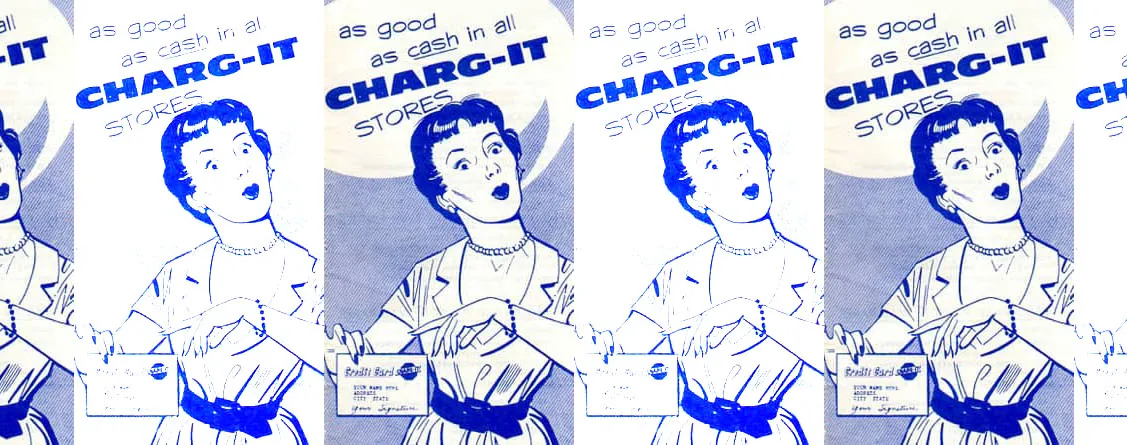The True Origin Of The Credit Card
Posted on 17 March, 2023 by MIRANDA BOTTAS in Finance

We All Carry Them In Our Wallets or Purses, But Where Did Credit Cards Truly Originate?
We could easily begin this article with a lengthy intro discussing how credit cards are an integrated part of our daily lives, and how it'd be hard to imagine a life without them. But that's how all of these articles start, and there's very little purpose in telling you things you already know just to fluff up the story. With that said, let's get into the facts about the true origin of the credit card and how it turned into what we know today.
In the year 1946, John C. Biggins was employed by Flatbush National Bank, located in Brooklyn. With the intent of providing convenience to existing customers, improving the sales of various local businesses and as a marketing tool to attract more new clients to his bank, he released the first kind of off-site credit guarantee for consumer purchases. It was called "Charg-It", and it allowed users to make purchases in the same manner as if they were using cash. However, there were a few stipulations that made this card unique.
Charg-It Cardholders could only use their credit at participating retailers. What's interesting is these retailers were limited mostly to the immediate area in Brooklyn. But, it was believed to begin - partly due to proximity and logistics - only with businesses located on the same block as Flatbush National Bank, as it would have been simple for Biggins to sell his idea to the retailers/businesses that were close to the bank. Not to mention, this likely provided a good sense of security and made for an easy testing ground for something relatively new.
Charg-It worked like this: Anyone consumer who held the card could use it where it was accepted, and those merchants would then send the purchase receipts to the bank. The bank would pay the merchants for the purchased goods and then bill the Charg-It using customer. It was a system that worked well, and was a success.
One of the first consumer facing ads for Charg-It showed a surprised and intrigued-looking woman pointing at her card, with a somewhat traditional text bubble hovering over her that read "As good as cash in all CHARG-IT Stores".
Going Back Even Further
But what was happening before Charg-It was introduced? For lack of a better term, "in-house credit cards" were used in many instances, some dating back to the 1800's. These were referred to by many as "charge plates". While various credit systems were in play throughout history (you can read more about the history of the credit scoring system in our article here) there were also individual companies who issued charge plates. These were essentially tokens, coins, tags, and other similar sorts of numbered documentation which were used more or less in the same way as the Charg-It card. These instruments, however, were limited to use at that specific business or location, and were issued in-house - not by a bank like Biggins had accomplished with Flatbush National.
An improvement on charge plates was implemented in 1914, when Western Union introduced their "Metal Money", which allowed select customers to defer payment. This was a unique approach that expanded on the idea of a single store or pharmacy allowing a tag for credit, and permitted for the use of credit at businesses who operated as chains, franchises, or at various locations. As an example, if you had five or six locations, a customer could use their Metal Money at any of the branches.
Another Side Of The Story
If you do some very basic research, many sources keep the history and/or invention of the credit card rather short. They claim that the inventor of the credit card was a man named Frank McNamara along with his partner in business, Raplh Schneider. This famous duo were the ones who brought the idea infamous Diner's Club card into existence. Seeing that it was very noteworthy and grew rapidly, we must admit that it's understandable why the Diner's Club card was considered to be the first true credit card, however, as you've seen above the issue isn't so black and white.
The Diner's Club card was initially made from cardboard and was available for select person's to use at 27 participating restaurants - nothing more. Further, there were a mere 200 members at the beginning, who primarily became users though being friends, family, and acquaintances of the inventors. And while 200 people may not seem like a large user-base, the number explode to over 42,000 loyal users in just two years. Eventually, the Diner's Club card went international and was readily accepted in the UK, Canada, Mexico, and even Cuba making it massively successful.
Here Come The Banks
Naturally, seeing the success of the Diner's Club, it didn't take long for banks to jump on the bandwagon and start releasing their own products. While the banks took up the style of Charg-It in allowing consumers to utilize participating retailers and then pay at a later date, they also implemented the ability to carry the balance month-over-month. This is what we'd consider to be the most resemblant of today's modern credit card.
The first was issued by Bank of America as a sort of test program in 1958 when the institution sent out these cars to some of their wealthier customers in California. By 1966, the card became widespread and available to a huge number of customers. It was called the Bank Americard, and even though it resulted in notable cases of fraud and delinquency the bank stuck with the idea and successfully became the first true credit card to allow for revolving debt.
Today, credit cards are issued by every bank imaginable. Not only are they readily available, but their are a wide variety of cards to choose from which include specialized cards that cater to those who dine out, those who travel, and those who simply shop a lot in general. Almost every major department store has their own lines of credit, and many financial institutions have sprouted up with the sole purpose of offering credit cards and nothing more, to the point where many of these card issuers aren't even what would be considered a traditional bank.
Credit is abundant, and without it the world of finance would come to a rapid halt. We rely on credit and financing as much as we rely on our employers to pay us, and yes, as we stated in the beginning of this article, it would be hard to imagine a modern day life without any form of credit.

PREVIOUS ARTICLE
Is 2023 The Most Important Year Ever For Good Credit?
NEXT ARTICLE
Housing Affordability At Lowest Level Ever
